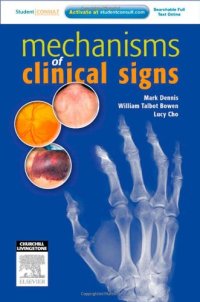
Ebook: Mechanisms of Clinical Signs
- Genre: Medicine
- Year: 2012
- Publisher: Churchill Livingstone
- Edition: 1
- Language: English
- pdf
The first consolidated textbook explaining the mechanism of clinical signs commonly seen in medicine. Mechanisms of Clinical Signs is the first consolidated text of its kind; designed to help medical students and junior doctors understand the pathophysiological mechanisms behind clinical signs. Unlike existing clinical examination textbooks which are predominantly organised by disease systems and states, Mechanisms of Clinical Signs is arranged by body system; bridging the gap between identifying clinical signs and understanding the causes behind them. Presented in a useful handbook style, Mechanisms of Clinical Signs discusses the evidence base and clinical value of each clinical sign to assist with interpretation. Examples are plentiful and include such signs as distinctive tremors in a Parkinson's disease patient and red hands on a patient with liver disease. As well as being an easy-to-follow reference for clinical signs seen on the ward, Mechanisms of Clinical Signs is an excellent study aid - particularly useful for those preparing for 'Viva' or 'OSCE' practical stations. The ability to accurately identify and interpret clinical signs of disease upon examination is a vital first step in correct diagnosis and treatment. Mechanisms of Clinical Signs is therefore an essential textbook for medical students and new practitioners. Online StudentConsult resources accompany Mechanisms of Clinical Signs upon purchase.
. first consolidated text explaining the mechanism of clinical signs commonly seen in medicine
. easy reference guide for clinical signs seen on the ward or during examinations
. a resource for those preparing for "Viva” or "OSCE” practical stations where students see patients and are asked specific questions relating to the clinical examination
. organised by body system it reviews the common clinical signs seen in diseases by the main system or specialty of medicine in a convenient handbook style
. each chapter contains all the clinical signs, a description of the sign, the disease/s in which the sign appears and an explanation as to the mechanism
. evidence base and clinical value of the sign is discussed to assist interpretation
. Online Student Consult resources accompany the text